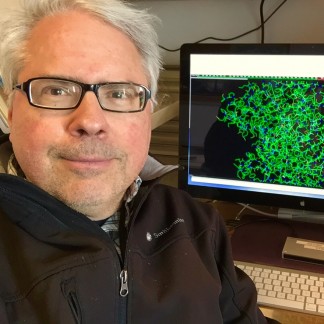
What do you do?
I am a Research Associate Professor of Medicinal Chemistry in the Institute for Therapeutics Discovery and Development. I work with other biomedical researchers at the University of Minnesota and Mayo Clinic to translate basic science ideas toward commercialization and drugs. My basic skills are in synthetic and medicinal chemistry and I also work in the area of cheminformatics.
What tools/software/hardware/etc do you use to do your work?
Most of my scientific work is done using the standard tools of communication like those in Microsoft Office. However, I also use specialty software such as Pipeline Pilot (a data analysis program that helps sort and analyze chemical structures and their associated numerical data) for handling the large amounts of data generated by our high-throughput screening group. I make use of ActivityBase software that stores screening results associated with chemical compounds in our 300,000 compound library, and Spotfire, a data visualization software package that allows our teams to view compound data in multidimensional space. Additionally, my group uses software hosted by the Minnesota Supercomputer Institute such as the Schrodinger suite of computational chemistry programs.
For data sharing within my group I use Evernote, Dropbox, Google Drive, Padlet, and Slack. We also store research data in Elements electronic lab notebook. I use Pandora extensively for background music during the day, and try to discipline myself to take breaks using Pomodoro. I like to move around campus when I work so the easy access to secure wi-fi is great and I can even VPN in over the Starbucks Google wi-fi connections. Tethering with my iPhone helps in other places.
What do you use that you love? What do you use that you wish worked better?
I really love Evernote and wished more tools worked as well as it does. It functions seamlessly to share web pages, manuscripts, draft proposals, and other information and can be accessed anywhere by everyone in my group.
I wished that better, simple communication methods existed to help promote and support interdisciplinary work. I am not even sure what this would look like. Maybe just a chat room? E-notebooks could also be better. Most of the affordable ones appear to have been developed by engineers and not users. I think there is a market for more effective data archiving tools that can handle chemical information.
A Note From The Librarian
 If you’re looking for other suggestions for tools to fit together, the Libraries has a page on productivity tools to help you get started. We are also interested in helping people evaluate and select electronic laboratory notebooks like Elements.
If you’re looking for other suggestions for tools to fit together, the Libraries has a page on productivity tools to help you get started. We are also interested in helping people evaluate and select electronic laboratory notebooks like Elements.




